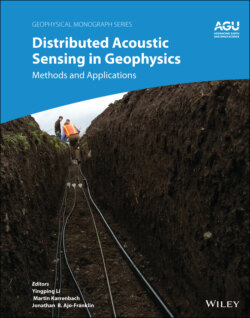Читать книгу Distributed Acoustic Sensing in Geophysics - Группа авторов - Страница 63
3.3. BOREHOLE SEISMIC SURVEY TESTS AND RESULTS 3.3.1. Zero‐Offset VSP Survey in Fushan Oil Field
ОглавлениеA field test using the DMOF‐based fiber optic DAS system was conducted in the Fushan oil field of China National Petroleum Corporation (CNPC) in China. A zero‐offset VSP survey was performed; its schematic is depicted in Figure 3.8a. A water‐filled source pit for the electrical spark seismic source was used to generate seismic energy on the surface near the wellhead. A 524‐m‐long sensing DMOF optical fiber cable with a tight buffer, strength member, and outer jacket was deployed into a cased borehole with a weight bar at the bottom to pull the fiber cable down in the borehole. The fiber cable was freely floated in the water‐injection‐filled borehole without any clamping, and the coupling between the fiber cable and the wellbore was realized by water.
Figure 3.8 Field test in the Fushan oil field: (a) Schematic of the zero‐offset VSP; (b) the DMOF‐based fiber optic DAS system recorded borehole seismic data (inset: amplitude spectra of the seismic data); and (c) Frequency‐wavenumber (F‐K) domain spectra of the recorded borehole seismic data using the DMOF‐based fiber optic DAS system.
From Figure 3.8b, it can be seen that the DMOF‐based fiber optic DAS system recorded the borehole seismic data with a good SNR and correct amplitude, as well as a clear downgoing tube wave. The output receiving data spacing is 2 m. The tube wave is the dominant component in the water‐filled shallow borehole, and the first arrival of the tube wave has an SNR of about 10 dB. In addition, Figure 3.8c presents the F‐K domain spectra of the recorded DMOF‐DAS borehole seismic data, where the linear event clearly indicates the strong downgoing tube wave and weak upgoing tube wave.
